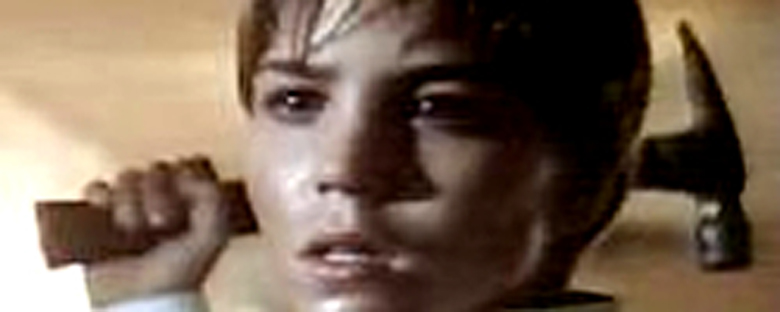Reviews
Joseph Ruben
USA, 1987
Credits
Review by Beth Gilligan
Posted on 30 October 2005
Source Nelson Entertainment VHS
Related articles
Features: 31 Days of Horror
Jason / says:
Jerry Blake is a perfectionist. He believes obsession is a good thing. Perfectionism keeps Jerry’s life ordered, and his family in their right place. When garbage accumulates or a material possession becomes ruined, he simply throws it out. And, when Jerry’s stepfamily becomes unruly or decides to color outside of the lines he’s laid out for them, he doesn’t think twice about hacking them to pieces and disposing of them too.
Jerry is a serial killer, and a serial stepfather. Jumping from family to family, he leaves considerable messes behind him (except for Norman Bates, a good boy even in murder, most horror movie killers do). Chronically underwhelmed by the families he joins, Jerry chops his way through disappointment, in a sense having found a solution — though not a practical one — for anybody who’s dreamed of the perfect life, but just can’t handle the upkeep. This is not the hyperbolized horror world of The Shining, draped in trope and genre, or the casual divorce narrative of E.T. The Stepfather places front and center the notion that every child fears their stepparent, while exploiting the particularly ‘80s stigma of broken homes and familial messes that can’t be cleaned up, equating them within an equally messy, albeit far bloodier horror film scenario.
I’ve asked Beth to write on The Stepfather not because I expect her to confirm my love of this film theme for theme (she might not even like the movie). I’ve asked Beth to write about The Stepfather because, love it or hate it, she will no doubt help me see this movie in a new and exciting way, which is really all you can ask of a good review. To be able to request that a peer analyze a favorite film of mine is an exciting opportunity, and a lot of fun at that.
Beth / says:
Poor Jerry Blake. All he wants is a picture perfect, Leave it to Beaver family life, but everyone keeps disappointing him. In the opening scene of The Stepfather, the audience is treated to a grisly glimpse of the effects such disillusionment can have on a fellow: standing stark naked, a crazed Jerry (played with creepy panache by Terry O’Quinn) faces the bathroom mirror and begins shaving off the wild beard he has grown and removing traces of blood from his hands. After a quick shower, he strolls downstairs into his living room, where the remaining members of his family lie stabbed to death, and casually begins picking up some of the children’s toys strewn on the floor. He then makes his way out the door, whistling merrily as he embarks on a new life.
A year later, Jerry seems to have found everything he’s looking for: a beautiful new wife, a spacious home on a tree-lined street, a job in real estate, and a little dog to greet him when he arrives home. The only glitch in his plan is his 16-year-old stepdaughter, Stephanie. Still reeling from the death of her father the previous year, Stephanie eyes the new intruder in her home with a healthy degree of resentment. However, when she hears about the murders that occurred around the same time Jerry moved to the area and met her mom, and when she later catches him ranting and raving to himself in the basement, her exasperation with her stepfather turns into fear and suspicion, as she tries to figure out exactly how far he will go to realize his dreams of an ideal family.
Given that the film was released in 1987, it is tempting to view Jerry as someone who took Ronald Reagan’s much-touted ideas about family values and ran a little too far with them. At the same time, The Stepfather openly feeds on the paranoia of a generation of teenagers who increasingly found themselves having to confront divorce and stepparents. Murderous tendencies aside, Jerry does, after all, carry many plausible stepparent traits, such as his heavy-handed insistence on family bonding and monitoring of his teenage stepdaughter’s dating life.
While the film arguably would have been more interesting had director Joseph Ruben adopted the Shadow of a Doubt template and left the audience, along with Stephanie, guessing as to whether or not Jerry was a homicidal maniac, this lack of depth is precisely what makes The Stepfather so much fun. While many suspense movies concoct an elaborate backstory that attempts to explain their protagonists’ murderous tendencies, screenwriter Donald Westlake merrily refuses to dump Jerry on the psychiatrist’s couch. A brief, perfunctory reference to a troubled childhood comes late in the film, but otherwise no attempts are made to explain why Jerry is so insistent on having the perfect family life, and why he unblinkingly murders those who get in the way of his plan. As a result, the movie has more than its fair share of camp moments, but for modern audiences, that may be one of its selling points.
We don’t do comments anymore, but you may contact us here or find us on Twitter or Facebook.



